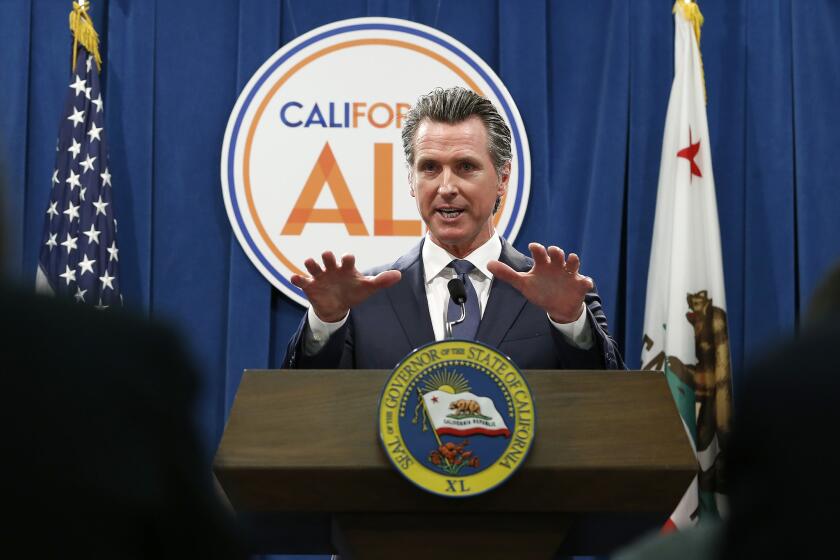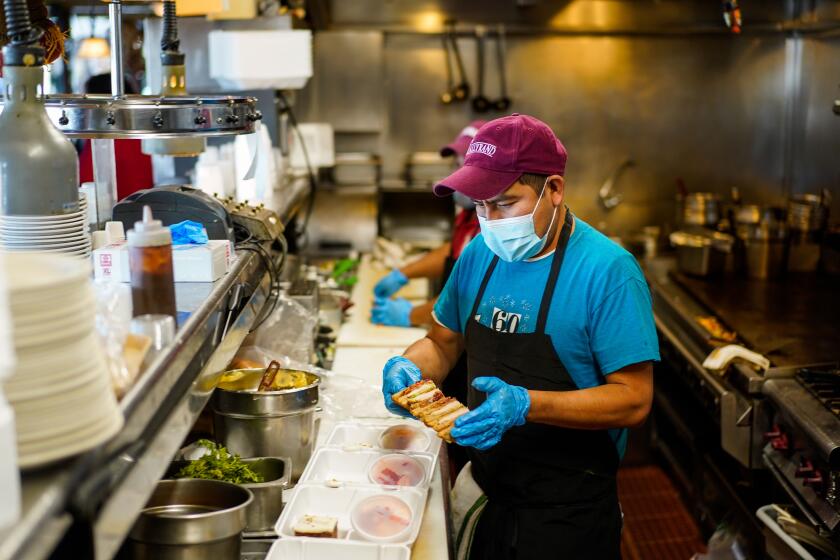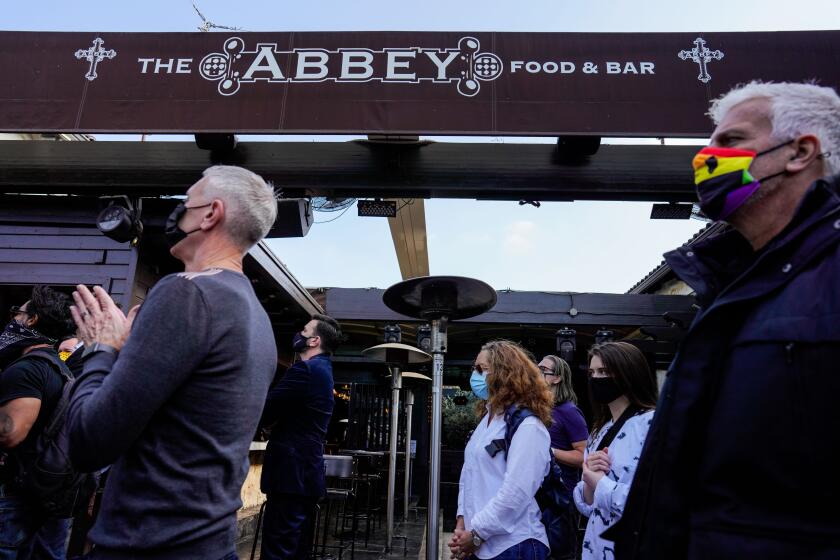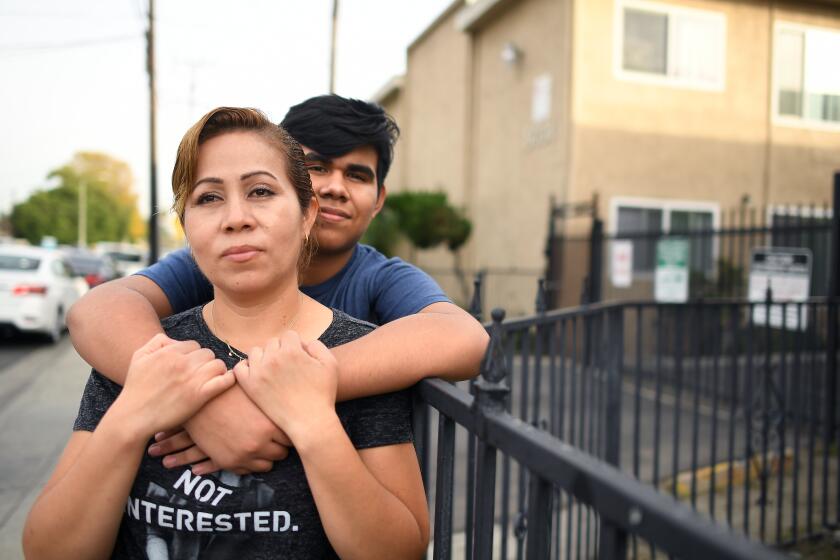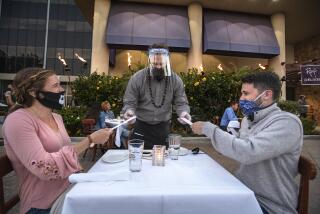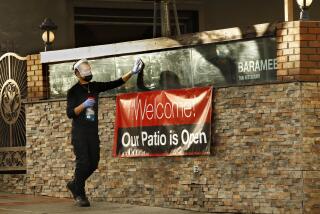California pioneered the COVID-19 stay-at-home lockdown. Now, it faces a backlash
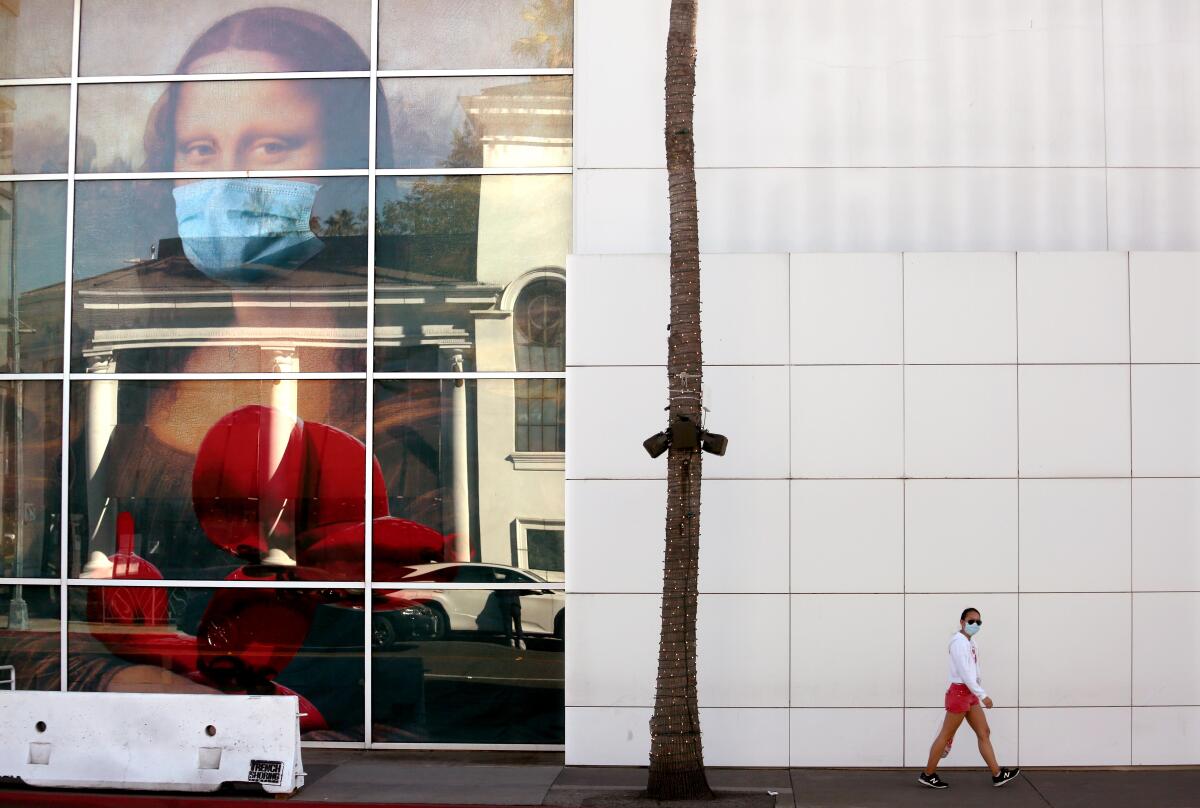
- Share via
With coronavirus hospitalizations surging in California and healthcare providers increasingly under strain, officials are eyeing a return to the kind of stay-at-home restrictions that helped curb the virus’ spread in the spring.
What is unclear, though, is whether residents will stomach even a modified lockdown as willingly as they did in March and April, when California’s swift and sweeping action made it an early national model in the battle against the coronavirus.
The surging infection numbers across the state, experts and officials say, indicate that many are already weary of restrictions and, in the midst of the holiday season, less inclined to stay home.
The politics of the pandemic also play a role. A cadre of cities and organizations have risen to challenge stricter rules imposed by Los Angeles County in the last week.
Beverly Hills and a few smaller cities are talking about creating their own public health departments, saying the county’s rules are too strict and not backed up by data. The restaurant industry was in court Wednesday challenging the suspension of outdoor dining, while card clubs have lobbied officials to allow them to reopen.
Others have cried hypocrisy after several top officials — including Gov. Gavin Newsom and the mayors of San Francisco and San Jose — engaged in the same kind of dining activities they have urged the public to avoid.
Additional closures of California businesses and activities will be based on projections of regional intensive care unit capacity.
But without further action, California risks one of the worst public health catastrophes in the state’s modern history, with the state’s death toll of nearly 20,000 plausibly doubling by the end of winter. Already, intensive care units in a number of hospitals statewide are close to reaching their normal staffed capacity.
Some of the anger stems from California instituting painful pandemic control measures without having experienced the kind of full-blown catastrophe seen elsewhere, said Dr. Kirsten Bibbins-Domingo, chair of UC San Francisco’s Department of Epidemiology and Biostatistics.
“What we really need is leaders to, I think, lead more out of hope and not out of fear,” Bibbins-Domingo said. “We have two highly effective vaccinations just around the corner…. We have an end in sight to the pandemic. But we have to get through the next month” to avoid an “exponential rise in cases, transmissions, hospitalizations and death.”
The Newsom administration has been working on a new statewide order that could be as far-reaching as the shutdown ordered in March. Such an order could be announced as early as Thursday. Some local health officials are pushing for statewide rules, saying the piecemeal approach has become problematic.
“Our local measures just by themselves are not enough. They’re not sufficient without these broader steps being taken at the state and federal level, both,” James Williams, the county counsel of Santa Clara County, said Wednesday. “We think it is absolutely critical that there be bold and swift state and federal measures to deal with the surge.”
California was the first state to impose a stay-at-home order, and its success prompted others to follow suit in the spring.
When rapid reopenings led to a new coronavirus surge over the summer, California unveiled a new system that, for several months, appeared to work as intended. Polls taken in the summer and spring showed strong support for the rules.
With even more stringent requirements back on the table, and residents fatigued after months of living with COVID-19, health officials are becoming increasingly blunt in their language and messaging.
“We do have a choice to make, each one of us: Do we want to be part of the solution to this horrifying surge, or do we want to be the problem?” L.A. County Public Health Director Barbara Ferrer said during a briefing Wednesday. “Because where you fall in this effort now has a life-or-death consequence, possibly for people you know and love, but certainly for people across the county who are loved by others.”
Los Angeles issued a modified stay-at-home order Wednesday night mirroring new L.A. County rules. “Just be smart and stay apart,” Mayor Garcetti said.
Meanwhile, the distressing news continues to pile up.
The number of Californians hospitalized with the coronavirus rose to a record high for a fourth straight day — rising past 8,500 in data released Wednesday amid continued concerns that a sustained increase in new cases will swamp the state’s healthcare system.
Though the 8,517 hospitalizations are unprecedented, officials caution that the figure will not represent the ceiling of the latest surge, as it largely excludes anyone who was only recently infected, including over the Thanksgiving weekend.
Despite the grim outlook, skepticism appears to be building at least in some quarters about whether more shutdowns are the answer.
The Beverly Hills City Council voted unanimously Tuesday to oppose the county’s outdoor dining ban and asked staff to research the idea of forming an independent public health department that would allow the city to set its own rules. Lancaster and a few other cities have also talked about this approach, though it remains to be seen how many will earnestly pursue a breakaway effort.
Pasadena, which has its own city health department, has decided not to follow the county’s lead and has seen business boom at its outdoor dining spots.
In a resolution that calls for the L.A. County Board of Supervisors to repeal the ban, Beverly Hills council members cited the detrimental effect on businesses and said there was a lack of scientific evidence to support the move. The action brought cheers from some hard-pressed restaurant owners.
“Our business has been devastated,” said Steve Scott Springer, general manager of Spago Beverly Hills. “We already had to lay off 100 employees. Now we’ve laid off 60 more.”
Gov. Gavin Newsom has announced a stay-at-home order affecting most of California.
The South Bay Cities Council of Governments, a joint powers authority of 16 cities and parts of the county, recently sent a letter to Newsom asking that he “reconsider allowing significantly large areas that are less impacted by COVID cases and hospitalizations to have more local control over the restrictions on businesses in their area.”
“It is time to replace the ‘one-size-fits-all policies’ with an ability to adopt local restrictions in designated areas,” the letter states.
Restaurants are also trying to overturn L.A. County’s ban in court.
Outdoor dining had offered a lifeline for struggling restaurants during the pandemic. The California Restaurant Assn. sued to stop the ban, with a downtown L.A. restaurant, Engine Co. No. 28, filing a similar suit.
A judge on Wednesday ordered public health officials to show scientific evidence justifying the measure. The county must return to court Tuesday to present evidence supporting the ban, L.A. County Superior Court Judge James C. Chalfant said at a hearing.
A judge on Wednesday ordered Los Angeles County public health officials to show scientific evidence justifying the outdoor dining ban imposed last week amid soaring coronavirus cases.
“You have to do a risk-benefit analysis for public health. You don’t just talk about the risk of spreading disease. You have to talk about the benefit of keeping restaurants open,” Chalfant said.
Chalfant expressed some skepticism about the ban. Based on the studies he has reviewed, the risk of spreading the coronavirus from outdoor dining appears minimal, he said.
But the county should have a chance to “answer those questions and fill those holes,” the judge said.
It’s not just the restaurant rules that have come under fire.
A school district survey asks parents in L.A. to look ahead to the near but indefinite future, when campuses could reopen for in-person classes, even as health officials project dark weeks ahead.
On the first day that card clubs in L.A. County were forced to close because of rising coronavirus cases, representatives for the casinos and the cities where they operate urged officials to allow them to reopen, citing the financial strain.
The card clubs were originally closed in March but were allowed to reopen only in outdoor settings in early October. The casinos were ordered to close again Monday.
“Shutting down our casinos is like shutting down our cities,” City of Commerce Mayor Ivan Altamirano said during a news conference at the Commerce Casino.
The view of shutdowns is different for some who have lost loved ones to COVID-19.
Remy Tateishi is mourning the death of her husband of 21 years, David Paul Harris, a 54-year-old deputy attorney for the California Department of Transportation.
Tateishi said she and her husband were diligent about protecting themselves — wearing masks and keeping distance from others. Several times a week, Harris underwent dialysis treatments. In preparation for an Oct. 7 medical procedure, Harris took a coronavirus test, and the results came back positive. About a week later, he became ill after returning from a dialysis treatment and was rushed to an intensive care unit.
On the last day they spoke, Tateishi heard her husband, through a video call, faintly say the words “I love you” underneath a large mask that muffled his voice. He repeated it over and over, even forming his hands in the shape of a heart. He died the next day, Oct. 20.
“People talk about, ‘I can’t go into a restaurant.’ They talk about little minute things they do, but they don’t see the impact,” Tateishi said. “I miss my husband so much. I never thought this would happen because we were so careful, every day…. He was so loving and he was so genuine … and now I look across the room and see his urn, it just kills me.”
Times staff writers Jaclyn Cosgrove, Hayley Smith, Hugo Martin and John Myers contributed to this report.
More to Read
Sign up for Essential California
The most important California stories and recommendations in your inbox every morning.
You may occasionally receive promotional content from the Los Angeles Times.
